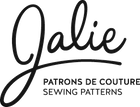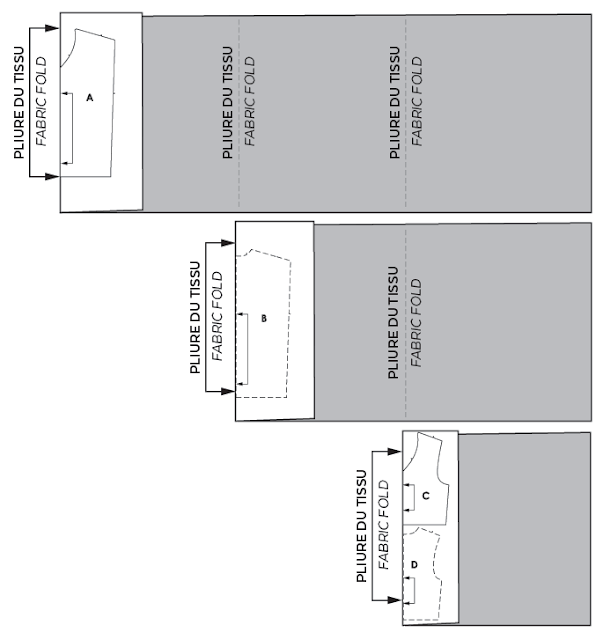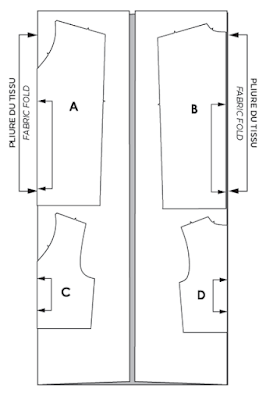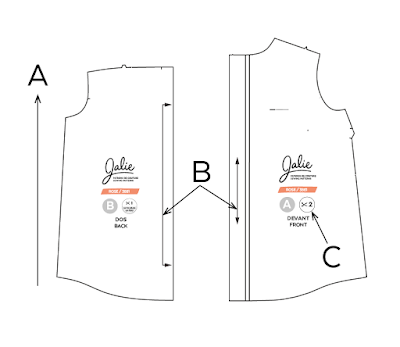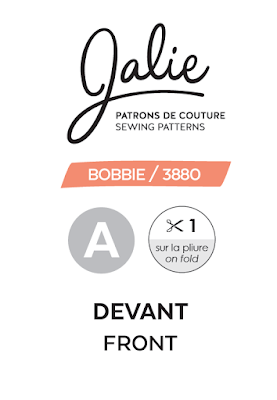Jalie 101: The Cutting Layout
After finding your size on the back of the pattern and having read the labels on your pieces, it's time to lay them out on the fabric.
The cutting layout we provide will allow you to use the yardage listed on the back of the fabric. It is a recommendation and is very helpful for people who want a little guidance to minimize fabric waste. If you have serious Tetris skill, could save even more fabric but it is important to understand the theory behind the cutting layout and follow the rules to have garments that hang straight.
The cutting layout we provide will allow you to use the yardage listed on the back of the fabric. It is a recommendation and is very helpful for people who want a little guidance to minimize fabric waste. If you have serious Tetris skill, could save even more fabric but it is important to understand the theory behind the cutting layout and follow the rules to have garments that hang straight.
Terminology
You will find on the cutting layout some symbols or terminology that you may not be familiar with if you are new to the sewing world. They are crucial to understanding why some pieces are positioned a certain way. Once you know what those words mean, you will have more confidence when cutting or altering pattern pieces.
SELVAGE / SELVEDGE
No markings on the patternFinished edge of the fabric that does not unravel. Its texture might be a little different than the rest of the fabric and it could even be blank or have the manufacturer's information printed on it.
The selvage is important, it is your guide to find the grainline easily.
FOLD / FOLD LINE
Double-Point Arrow with Two Corners
When you buy your fabric at the store, it will most probably be folded on the bolt. That fold is "a" fold, but not might not always be exactly parallel to selvage. We will cover the fold position a little later. You know your foldline is correct and parallel to selvage when the fabric does not twist when you smooth it out. Remember to use selvage as guide, not the cut edges (fabric is very rarely cut at a perfect 90 degree in store :))
That original fold can be stubborn and difficult to remove when ironing or can sometimes be stained if it's a fabric that has been a long time on the shelf. Be careful not to have it on your piece if it's the case.
STRAIGHT GRAIN / GRAINLINE
Double-Point Straight Arrow
On woven fabric, the warp thread is easy to find and selvage is most of the time nice and flat. The grainline is the vertical line that is parallel to selvage. It is very important to know where your grainline is in order to have a "straight" garment.
In knits, selvedge can be difficult to find (or inexistent if you buy a tubular fabric). You can find it by folding and pinning along the rib that runs parallel to selvage, on the right side of the fabric.
The fold, straight grain and selvage are always parallel. If you had a vertical stripe print, the stripes would run along all three.WEFT
No markings on the pattern
The thread running from selvage to selvage. It is square with the grainline. Anything going straight across the body (horizontal seam, straight hem, sleeve hem) is most of the time aligned with it.
TRUE BIASNo marking on the pattern
This one is invisible. It runs 45° with the selvage and is used when stretch is required in a woven fabric (for binding pieces for example).
How to Cut Multiple Pieces on the Fold
When many piece are cut on the fold, you may find a layout like this where we show you to create a new fold line for each piece:You can also create two fold lines at once like this:
Understanding your pieces - It's as easy as A, B, C :)
The information in the cutting layout reflects the information you see on the pieces:
A // KNOW WHERE THE TOP OF YOUR PIECE IS
The cutting layout is pretty straight forward, but you have to pay attention when positioning your fabric. The top of the layout is the top of the garment. This means that if your fabric has a nap, you have to make sure the fabric had the top in the right position. You would not want to end up with upside-down birds on your shirt!
The cutting layout is pretty straight forward, but you have to pay attention when positioning your fabric. The top of the layout is the top of the garment. This means that if your fabric has a nap, you have to make sure the fabric had the top in the right position. You would not want to end up with upside-down birds on your shirt!
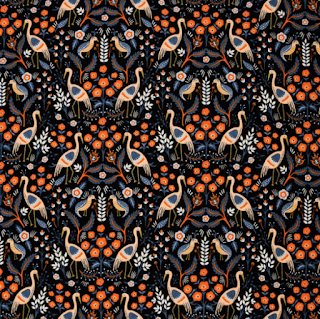 |
| Coton Rifle Paper Co de chez Club Tissus |
B// STRAIGHT GRAIN / GRAINLINE
Those lines always have to be parallel to the fabric grain. Measure from selvage to the marking, at both ends to ensure the piece is nice and straight.
C// HOW MANY PIECES YOU NEED
Here are the most common options for cutting:
- ✂︎1: Cut one // It means you only need one.
It's always a good idea to cut it with the right side of the fabric facing up, especially for asymmetrical designs. For example, on the 3136 skating dress, if you want the long edge of the skirt on the right or leg leg, or on the 3354 asymmetrical gymnastics leotard if you want the contrast strap on the right or left shoulder.
- ✂︎2 : Cut two // It means you need two pieces.
We take into account that you use the cutting layout (cut your piece on the folded fabric). This means that two pieces will be mirrored, not identical.
- ✂︎4 : Cut four // This would mean you have to use the paper piece twice in most cases.
You will cut two pairs to have a total of 4, two pairs or mirrored pieces.
- ✂︎1 on fold // You need to fold your fabric (remember, the fold being parallel to the selvage / grainline, not necessarily the fold from the bolt).
A good habit is to mark the fold position on your cut piece (with a marker or tiny clip) as it will most often be the center of something (center front or center back for example). - ✂︎2 on fold // Same thing as above but you have to do it twice.
It is most often seen on our sleeve pieces or things like pockets or shirt collars. It means you have to use the paper piece twice. Cut one piece on fold, then repeat for the other one (keeping the same fold line or refolding to waste less fabric as shown in the cutting layout example above)
Good layout = Free Undies!
With the same length of fabric, folding the fabric properly can either end up with tiny scraps you can't make anything with OR enough fabric for smaller garments like underwear or even a fun contrast sleeve on a t-shirt!
It's always a good habit to fold the fabric to cover only the pieces you need to cut. Don't fold the fabric in half if you don't need to. Here is an example of the difference in the sizes of the remnants with a different fold position for the Clara Leggings:
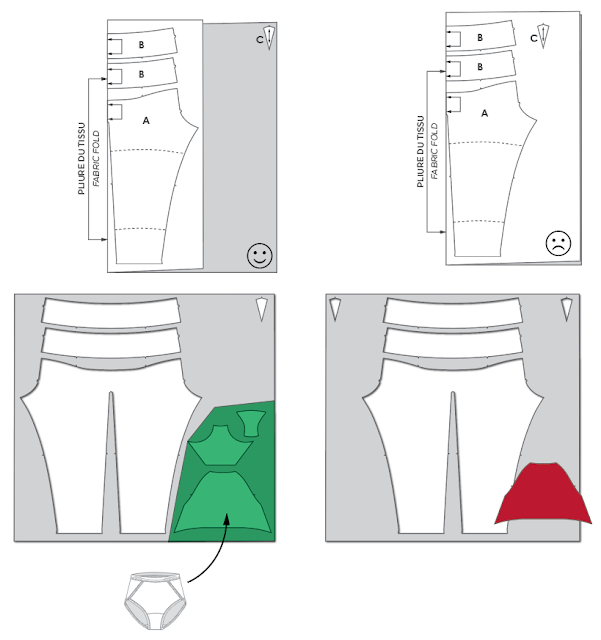 |
| If you fold the fabric to the width of your pieces (instead of folding in half), you could get enough fabric for Julia panties! |
The exception to that rule would be with some prints where you have to position pieces carefully to avoid the odd "boob flower" or "eyes" or having a large diamond or beautiful panel repeat slightly off-center on the front of your top or worse!
Washing the Fabric
Some fabrics shrink a lot, even without putting them in the dryer. The last thing any sewist would want is to see a perfectly sewn shirt, with the sizing chosen carefully go 1-2 size smaller after a wash. Even though it takes some extra time, wash your fabric before cutting your garment. Some fabrics can be a bit trickier to manipulate after a wash, but that is a small price to pay for clothes that fit. Also, if it's wrinkled, take the time to iron it before your fold it / put it away.
← Jalie 101 : Understanding the Pattern Pieces Jalie 101 : Understanding the Pattern Pieces →

